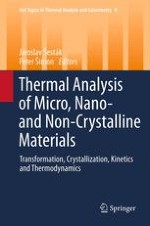Thermal Analysis of Micro-, Nano- and Non-Crystalline Materials: Transformation, Crystallization, Kinetics, and Thermodynamics complements and adds to volume 8 Glassy, Amorphous and Nano-Crystalline Materials by providing a coherent and authoritative overview of cutting-edge themes in this field. In particular, the book focuses on reaction thermodynamics and kinetics applied to solid-state chemistry and thermal physics of various states of materials.
Written by an international array of distinguished academics, the book deals with fundamental and historical aspects of phenomenological kinetics, equilibrium background of processes, crystal defects, non-stoichiometry and nano-crystallinity, reduced glass-transition temperatures and glass-forming coefficients, determination of the glass transition by DSC, the role of heat transfer and phase transition in DTA experiments, explanation of DTA/DSC methods used for the estimation of crystal nucleation, structural relaxation and viscosity behaviour in glass and associated relaxation kinetics, influence of preliminary nucleation and coupled phenomenological kinetics, nucleation on both the strongly curved surfaces and nano-particles, crystallization of glassy and amorphous materials including oxides, chalcogenides and metals, non-parametric and fractal description of kinetics, disorder and dimensionality in nano-crystalline diamond, thermal analysis of waste glass batches, amorphous inorganic polysialates and bioactivity of hydroxyl groups as well as reaction kinetics and unconventional glass formability of oxide superconductors.
Thermal Analysis of Micro-, Nano- and Non-Crystalline Materials: Transformation, Crystallization, Kinetics, and Thermodynamics is a valuable resource to advanced undergraduates, postgraduates, and researches working in the application fields of material thermodynamics, thermal analysis, thermophysical measurements, and calorimetry.
